The first line a person typically looks at on the palm is the line of life. It is also frequently the most prominent line on the palm as it arcs around the mount of Venus, reaching somewhere near the wrist. The line of life is not an indicator of longevity. What it does reveal, however, is the quality of your life.
We observe the line’s condition to judge how a person manages their world. Ideally, it is well-defined without deviations or markings. However, that is not likely to occur today due to busy and demanding lives. The line of life also indicates the subjects’ physical strength and health during various periods of life.
Examining it is also essential in obtaining confirmation and timing of events because through the markings along it there is a capacity for seeing considerable changes. The line can alter, shift or even fade as circumstances change. However, consider all indicators from the palm before making assumptions, as some factors can offset (or support) the findings.
The Life Line Starting Point
The start of the life line does not always commence at the same position, occasionally starting close to the thumb and other times as high as the Mount of Jupiter. If it sits high, it shows an ambitious and confident nature. Occasionally it can begin joined with the head line and appear like a branch from it, which means a much more insecure yet family-orientated spirit. These types show much less confidence than those with a separate line from the head line.
The Long Life Line
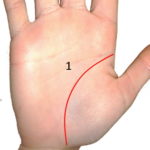
- A long steady line shows vitality, routine, stability, motivation and someone who perhaps does not need to depend on anyone or anything. They have strong family roots and stick close to their traditions. Most tend to know exactly what they want from life. The long line without branches or deviations suggests little change in life. It is easier to read a long life line because potential disturbances are recorded in the timeline. A thick, long, well-defined and unmarked line depicts a reliable and robust nature. They are grounded with strong family roots and like to settle down in one place. They usually know what they want in life. The downside with this type of line is that the person may not be open to change or unaware of things such as health issues that might come by surprise.

Short life line
2. The short life line is common in the hands of those who don’t specifically follow family traditions. It shows a freedom-loving individual who is not so strict on routine. It is as if the path of life is not set, either through circumstance or conscious decision. This attitude might have come from a family that is not settled or even a broken family (the parents). A short life line can appear ‘weak,’ so for someone with this line, finding a place to settle down and sticking to a routine and setting goals, strengthens a weak life line. The type of work or hobbies you have can also affect the shape and length of the line. People with a short life line tend to have an air of uncertainty around them. They might be unclear about their goals in life or get bored easily.
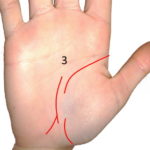
A broken line with a branch at the end
3. A broken line is when a section of the line is missing before the line continues. A clean break shows uncertainty for health or other parts of life. It may show that change is necessary, whether due to relocation, illness, or other experiences, and it serves as a cautionary to take more care during that time. A break in a line depicts change because the proper flow of the energy is interrupted, leaving a space that may necessitate a decision for transformation or a breather in life.
Get Life and Destiny Palmistry Book Here from USA My Choice of Other Recommended Palmistry BooksOverlapping break
If the line continues actively after the break, it shows the usual flow of things is resumed. If not, look for a bridge line (often very faint) that connects to the fate line. In many cases, the fate line acts as a life line to support a change in a new direction. Also, see if sister lines are on one or both sides; these lines support an otherwise uncertain period. A line on the inside of the life line would show family support, and on the outside from a non-related source. If the break overlaps another part of the line, it often indicates a planned change. The branch at the end depicts travel or moving to another country.
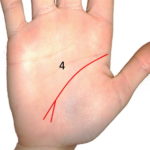
A straight line with a fork at the end
4. A straight life line that arches widely towards the mount of Moon depicts an outgoing and restless person with many interests. They will have a love of travel and a change of scenery. The fork at the end suggests that sometime in their later years they will have a decision regarding travel or change in location. It is possible that the subject will have two places of residence.
Double life line or thin line
5. On the non-dominant hand, the double line can represent two distinct ethnic values or family backgrounds. These people often feel the presence of a spirit guide or have a healthy spiritual belief system. On the dominant hand, it gives the line added strength and protection. These individuals typically have an abundance of energy and recover quickly from illness. A well-formed secondary line can also show two different sides of character or lifestyle.
If the main line is thin, it indicates a subtle and quiet personality but one who is receptive enough to know in advance when difficulties arise. While they may have energetic moments, they do not usually last. A fork at the end can depict travel later in life.
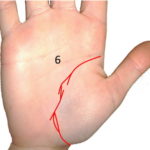
Island on the line or drooping lines
6. A drooping line on the inside of the line shows worry or loss. When the whole line seems to break and change in direction, it depicts life’s trials and tribulations. An island is a divided line that slows down the normal energy flow. The result is usually a decrease in energy, a divided family, or a period of illness or menopause. It can describe a low resistance period if the island has been present for a long time with no apparent problems. In some circumstances, it shows a troubled or unstable time. Check other lines for clues. The heart line might show marks if it is emotional. The fate line might show marks if it is financial.
Check out the free video lessons by Sari here.
You can get the book here.
WEBSITE NOTICE: The author disclaims any liability or responsibility to any person or entity concerning any outcome, loss or damage caused directly or indirectly by utilising any information presented on this website and intended for general advice and or entertainment purposes only.
My Choice of Other Recommended Palmistry Books